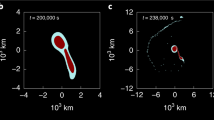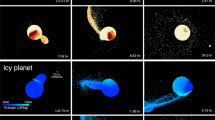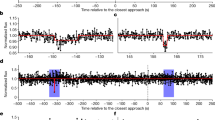Abstract
The Cassini spacecraft revealed the spectacular, highly irregular shapes of the small inner moons of Saturn1, ranging from the unique 'ravioli-like' forms of Pan and Atlas2,3 to the highly elongated structure of Prometheus. Closest to Saturn, these bodies provide important clues regarding the formation process of small moons in close orbits around their host planet4, but their range of irregular shapes has not been explained yet. Here, we show that the spectrum of shapes among Saturn’s small moons is a natural outcome of merging collisions among similar-sized moonlets possessing physical properties and orbits that are consistent with those of the current moons. A significant fraction of such merging collisions take place either at the first encounter or after 1–2 hit-and-run events, with impact velocities in the range of 1–5 times the mutual escape velocity. Close to head-on mergers result in flattened objects with large equatorial ridges, as observed on Atlas and Pan. With slightly more oblique impact angles, collisions lead to elongated, Prometheus-like shapes. These results suggest that the current forms of the small moons provide direct evidence of the processes at the final stages of their formation, involving pairwise encounters of moonlets of comparable size4,5,6. Finally, we show that this mechanism may also explain the formation of Iapetus’ equatorial ridge7, as well as its oblate shape8.
This is a preview of subscription content, access via your institution
Access options
Access Nature and 54 other Nature Portfolio journals
Get Nature+, our best-value online-access subscription
$29.99 / 30 days
cancel any time
Subscribe to this journal
Receive 12 digital issues and online access to articles
$119.00 per year
only $9.92 per issue
Buy this article
- Purchase on Springer Link
- Instant access to full article PDF
Prices may be subject to local taxes which are calculated during checkout




Similar content being viewed by others
References
Thomas, P. C. Sizes, shapes, and derived properties of the saturnian satellites after the Cassini nominal mission. Icarus 208, 395–401 (2010).
Charnoz, S., Brahic, A., Thomas, P. C. & Porco, C. C. The equatorial ridges of Pan and Atlas: terminal accretionary ornaments? Science 318, 1622–1624 (2007).
Porco, C. C., Thomas, P. C., Weiss, J. W. & Richardson, D. C. Saturn’s small inner satellites: clues to their origins. Science 318, 1602–1607 (2007).
Charnoz, S., Salomon, J. & Crida, A. The recent formation of Saturn’s moonlets from viscous spreading of the main rings. Nature 465, 752–754 (2010).
Hyodo, R. & Ohtsuki, K. Saturn’s F ring and shepherd satellites a natural outcome of satellite system formation. Nat. Geosci. 8, 686–689 (2015).
Crida, A. & Charnoz, S. Formation of regular satellites from ancient massive rings in the Solar System. Science 338, 1196–1199 (2012).
Porco, C. C. et al. Cassini Imaging Science: Initial results on Phoebe and Iapetus. Science 307, 1237–1242 (2005).
Thomas, P. C. et al. Shapes of the saturnian icy satellites and their significance. Icarus 190, 573–584 (2007).
Goldreich, P. & Tremaine, S. Disk-satellite interactions. Astrophys. J. 241, 425–441 (1980).
Karjalainen, R. Aggregate impacts in Saturn’s rings. Icarus 189, 523–537 (2007).
Jutzi, M. & Asphaug, E. The shape and structure of cometary nuclei as a result of low velocity collisions. Science 348, 1355–1358 (2015).
Wisdom, J. The resonance overlap criterion and the onset of stochastic behavior in the restricted three-body problem. Astron. J. 85, 1122–1133 (1980).
Deck, K. M., Payne, M. & Holman, M. J. First-order resonance overlap and the stability of close two-planet systems. Astrophys. J. 774, 129 (2013).
Poulet, F. & Sicardy, B. Dynamical evolution of the Prometheus–Pandora system.Mon. Not. R. Astron.Soc. 322, 343–355 (2001).
Benz, W. & Asphaug, E. Simulations of brittle solids using smooth particle hydrodynamics. Comput. Phys. Commun. 87, 253–265 (1995).
Jutzi, M., Benz, W. & Michel, P. Numerical simulations of impacts involving porous bodies. I. Implementing sub-resolution porosity in a 3D SPH hydrocode. Icarus 198, 242–255 (2008).
Jutzi, M. SPH calculations of asteroid disruptions: the role of pressure dependent failure models. Planet. Space Sci. 107, 3 (2015).
Hyodo, R. & Ohtsuki, K. Collisional disruption of gravitational aggregates in the tidal environment. Astrophys. J. 787, 56 (2014).
Asphaug, E., Agnor, C. B. & Williams, Q. Hit-and-run planetary collisions. Nature 439, 155–160 (2006).
Richardson, D. C. Tree code simulations of planetary rings. Mon. Not. R. Astron. Soc. 269, 493–511 (1994).
Thomas, P. C. Sizes, shapes, and derived properties of the saturnian satellites after the Cassini nominal mission. Icarus 208, 395–401 (2010).
Hamilton, D. P., Proctor, A. L. & Rauch, K. P. An explanation for the high inclinations of Thebe and Amalthea. Bull. Am. Astron. Soc. 33, 1085 (2001).
Castillo-Rogez, J. C. et al. Iapetus’ geophysics: rotation rate, shape, and equatorial ridge. Icarus 190, 179–202 (2007).
Singer, K. N. & McKinnon, W. B. Tectonics on Iapetus: despinning, respinning, or something completely different? Icarus 216, 198–211 (2011).
Ip, W.-H. On a ring origin of the equatorial ridge of Iapetus. Geophys. Res. Lett. 33, L16203 (2006).
Levison, H. F., Walsh, K. J., Barr, A. C. & Dones, L. Ridge formation and de-spinning of Iapetus via an impact-generated satellite. Icarus 214, 773–778 (2011).
Dombard, A. J., Cheng, A. F., McKinnon, W. B. & Kay, J. P. Delayed formation of the equatorial ridge on Iapetus from a subsatellite created in a giant impact. J. Geophys. Res. 117, E03002 (2012).
Stickle, A. M. & Roberts, J. H. Modeling an exogenic origin for the equatorial ridge on Iapetus. Icarus 307, 197–206 (2018).
Asphaug, E. & Reufer, A. Late origin of the Saturn system. Icarus 223, 544–565 (2013).
Murray, C. D. & Dermott, S. F. Solar System Dynamics (Cambridge Univ. Press, Cambridge, UK, 1999).
El Moutamid, M., Sicardy, B. & Renner, S. Coupling between corotation and Lindblad resonances in the presence of secular precession rates. Celest. Mech. Dyn. Astron. 118, 235–252 (2014).
Leleu, A., Robutel, P. & Correia, A. C. M. On the coplanar eccentric non-restricted co-orbital dynamics. Celest. Mech. Dyn. Astron. 130, 3 (2018).
Petit, A. C., Laskar, J. & Boué, G. AMD-stability in presence of first order mean motion resonances. Astron. Astro. 607, A35 (2017).
Benz, W. & Asphaug, E. Simulations of brittle solids using smooth particle hydrodynamics. Comput. Phys. Commun. 87, 253–265 (1995).
Jutzi, M., Holsapple, K. A., Wuenneman, K. & Michel, P. in Asteroids IV (eds Michel, P., DeMeo, F. & Bottke, W. F.) 679–699 (Univ. Arizona, Tucson, USA, 2015).
Collins, G. S., Melosh, H. J. & Ivanov, B. A. Modeling damage and deformation in impact simulations. Meteorit. Planet. Sci. 39, 217–231 (2004).
Jutzi, M., Michel, P., Hiraoka, K., Nakamura, A. M. & Benz, W. Numerical simulations of impacts involving porous bodies: II. Comparison with laboratory experiments. Icarus 201, 802–813 (2009).
Wisdom, J. & Tremaine, S. Local simulations of planetary rings. Astron. J. 95, 925–940 (1988).
Jutzi, M., Benz, W., Toliou, A., Morbidelli, A. & Brasser, R. How primordial is the structure of comet 67 P/C-G? Astron. Astro. 597, A61 (2017).
Jutzi, M. & Benz, W. Formation of bi-lobed shapes by sub-catastrophic collisions. Astron. Astro. 597, A62 (2017).
Collins, G. S. Numerical simulations of impact crater formation with dilatancy. J. Geophys. Res. Planets 119, 2600–2619 (2014).
Leinhardt, Z. M. & Richardson, D. C. & Quinn, T. Direct N-body simulations of rubble pile collisions. Icarus 164, 133–151 (2000).
Shoemaker, E. M. in Physics and Astronomy of the Moon Ch. 8 (Academic Press, New York, 1962).
Spitale, J. N., Jacobson, R. A., Porco, C. C. & Owen, W. M. Jr The orbits of Saturn’s small satellites derived from combined historic and Cassini imaging observations. Astron. J. 132, 692–710 (2006).
Dombard, A. J., Cheng, A. F., McKinnon, W. B. & Kay, J. P. Delayed formation of the equatorial ridge on Iapetus from a subsatellite created in a giant impact. J. Geophys. Res. 117,E03002 (2012).
Acknowledgements
The authors acknowledge support from the Swiss NCCR PlanetS and the Swiss National Science Foundation.
Author information
Authors and Affiliations
Contributions
A.L. performed the dynamical modelling and analysed the results. M.J. performed the collision modelling and analysed the results. M.R. contributed initial ideas for the study. All authors contributed to interpretation of the results and the preparation of the manuscript.
Corresponding author
Ethics declarations
Competing interests
The authors declare no competing interests.
Additional information
Publisher’s note: Springer Nature remains neutral with regard to jurisdictional claims in published maps and institutional affiliations.
Supplementary information
Supplementary Information
Supplementary Figures 1–9.
Rights and permissions
About this article
Cite this article
Leleu, A., Jutzi, M. & Rubin, M. The peculiar shapes of Saturn’s small inner moons as evidence of mergers of similar-sized moonlets. Nat Astron 2, 555–561 (2018). https://doi.org/10.1038/s41550-018-0471-7
Received:
Accepted:
Published:
Issue Date:
DOI: https://doi.org/10.1038/s41550-018-0471-7



